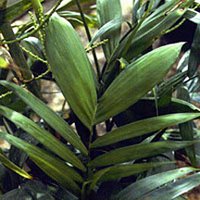Sunday, February 12, 2006
Asheville Real Estate Journal
 Asheville Real Estate Journal
Asheville Real Estate JournalRemedy for Toxins in Your Indoor Air
TOP 10 Indoor Plants ...
but be careful,six( 6) of these 9in red) are toxic to PETS!
Did you know that at least 300 volatile substances found inside many homes and places of business can make you and your family sick?
Ranging from detergents, gasoline, oils, plastics, rubber, synthetic fibers, tobacco, smoke, carpet, clothes, foam insulation, furniture, household cleaners, paper goods, dry cleaning, inks, lacquers, creosote, varnishes, adhesives, sealants, paints, particleboard, plywood, and timber treatments…you will find them without much trouble in any indoor space.
They are the culprits responsible, at least in part, for the “off-gassing” :that may result in asthma, heavy fatigue, conjunctivitis, chemical hypersensitivity syndrome and chronic degenerative conditions. and chronic headache. Think of this….we and our kids and grandkids hang out about ninety (90) percent of the time indoors. We are breathing volatile substances all the time. That’s the reason that indoor air quality is an important issue. The Environmental Protection Agency (EPA) found that indoor air is so polluted that it exceeds acceptable air pollution limits. One EPA report states that "indoor air pollution represents a major portion of the public's exposure to air pollution and may pose serious acute and chronic health risks."
But there is a remedy for this situation, and it is inexpensive and lovely to see.
Remember when you were in Fourth Grade and your teacher taught about plants and their amazing ability to absorb carbon dioxide and turn it into oxygen and carbohydrates? Plants have long been known as nature's air purifiers. They maintain the oxygen supply on this planet…inside and out. In addition, NASA scientists discovered that indoor plants can drastically reduce toxic chemical levels inside buildings. Photosynthesizing plants and their roots and associated microorganisms act to break down contaminants which are then taken up as nutrients. The Boston fern, chrysanthemum, dracaena and English ivy are very effective at removing the formaldehyde, benzene and trichloroethylene from indoor air.. .
Benzene, a contaminant that exists in tobacco smoke, plastics, paints, gasoline, inks, detergents and synthetic fibers, that can cause nervousness, dizziness, headaches and anemia, and also irritates eyes and skin. The following plants absorb this pollutant and break it down -- English ivy, gerbera daisy, chrysanthemum, devil's ivy (Epiprenum), peace lily (Spathiphyllum) and the ornamental corn plant (Dracaena marginata).
Formaldehyde, a contaminant found in foam insulation, paper towels and facial tissues, plywood, veneers, carpeting and household cleaners, can irritate mucous membranes and the upper respiratory tract and even can cause asthma. These plants can help to remedy the threat to wellness-- Boston fern, bamboo palm, philodendron, and chrysanthemum (again!), dwarf date palm, snake plant (Sansevieria) and the interesting looking spider plant.
Trichloroethylene, a known carcinogen that attacks the liver, is present in dry-cleaning solutions, and many inks, paints, varnishes, lacquers and adhesives. These plant-friends can overthrow this toxin --- chrysanthemum (yet again!), gerbera daisy, peace lily and two cultivars of Dracaena deremensis (Warneckii and Janet Craig).
P.S. The Dwarf date palm is most effective at removing xylene and the lady palm is a champ at breaking down ammonia.
Research has shown that the following 10 plants are the most effective all-around in counteracting off-gassed chemicals and contributing to balanced internal humidity.
TOP TEN (10) GREEN "REMEDIES"
* Areca palm * Reed palm * Dwarf date palm * Boston fern * Janet Craig dracaena * English ivy * Australian sword fern * Peace Lily * Rubber plant * Weeping fig




